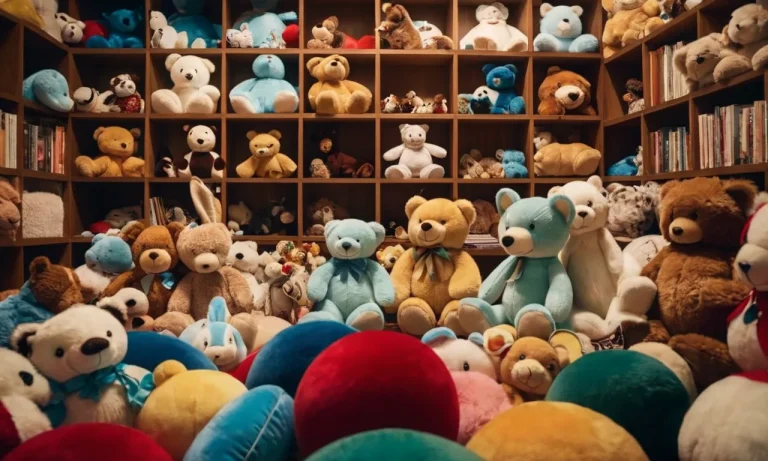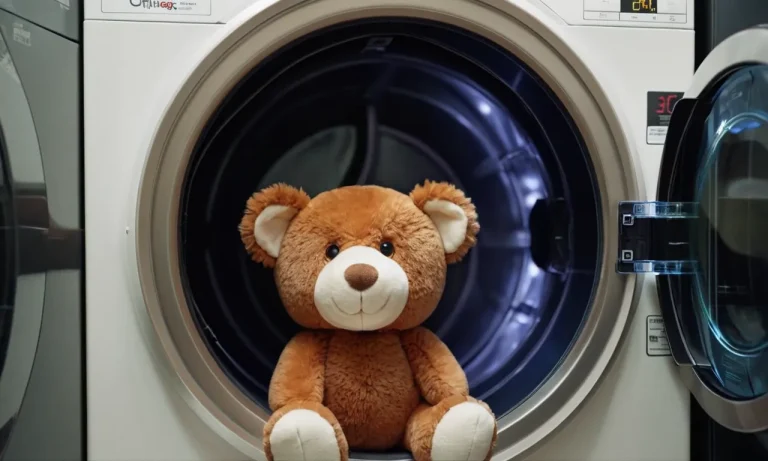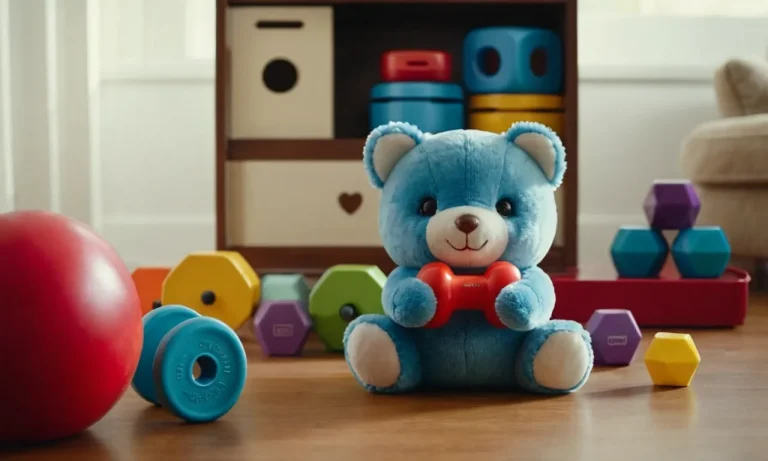Stuffed animals have been cherished by children and adults alike for generations. If you’ve ever wondered what fabric these cuddly companions are made from, you’ve come to the right place.
If you’re short on time, here’s a quick answer: most modern stuffed animals are made from plush, a knitted or woven fabric like fleece, velour, velveteen, cotton, or polyester.
In this comprehensive guide, we’ll explore the most common fabrics used to make stuffed animals over time, the shift from natural to synthetic fibers, the manufacturing process, tips for identifying materials, care recommendations based on fabrics, and much more.
A Brief History of Stuffed Animal Fabrics
Early Stuffed Animals Made from Natural Materials
Stuffed animals have been around for centuries, with some of the earliest examples being made from natural materials like straw, cloth, and wood. In the 1800s, stuffed animals started to gain popularity as toys for children.
These early stuffed animals were often hand sewn and filled with materials like horsehair, cotton, wool, kapok, excelsior, and sawdust.
Some of the most common natural fabrics used for early stuffed animal toys included felt, velvet, burlap, calico prints, and muslin. Felt was durable and could be made into a variety of animal shapes. Dense patterned fabrics like velvet or calico added visual interest.
Burlap made sturdy toy bodies that held their shape well. Lightweight muslins gave a soft, floppy feel for stuffed animals like rag dolls.
Natural materials had some drawbacks for toy use though. Fillers like horsehair, wool, or sawdust could sometimes poke through the toy’s outer fabric, causing injuries. Kapok and excelsior stuffings were highly flammable. Getting these fabrics wet also made the stuffing clump together.
So while natural fabrics dominated the early decades of the stuffed animal industry, man-made fabrics were on the rise.
Shift to Synthetic Plush Fabrics
In the mid 1900s, manufacturers started experimenting with synthetic alternatives to traditional stuffed animal fabrics. Materials like nylon, polyester, and acrylic offered more affordable production costs, bolstered safety, and introduced exciting new textures like plush and velour.
By the 1950s brands like Steiff and Gund were using synthetic fiberfill stuffings for most of their stuffed animals. This man-made stuffing was soft, hypoallergenic, lightweight, and able to retain its fluff after washing. Compared to natural stuffings, it far less prone to clumping over time.
And while early synthetics had issues with breathability, modern plush and velour fabrics are perfectly suited to snuggly stuffed playthings. They provide that satisfyingly soft feel children love, but are much more durable against washing, chewing, and loving to bits.
Today, the vast majority of stuffed animals are made from synthetic materials. And innovations in microfiber textiles and stuffing materials offer even more comfort, affordability and safety than ever before.
Most Common Modern Stuffed Animal Fabrics
Plush and Fleece
Two of the most popular fabrics for stuffed animals today are plush and fleece. Plush refers to a knit or woven fabric with a soft, fuzzy pile. It makes stuffed animals irresistibly soft and huggable! Fleece is a lightweight synthetic knit fabric that helps keep stuffed animals cozy.
Many modern stuffed animals are made from super-soft double-sided “minky” plush, which has a velvety texture on both sides. According to The Spruce Crafts, over 90 million yards of fleece and plush fabrics are used for stuffed animals each year in the US alone!
Velour and Velveteen
Velour and velveteen fabrics are also common for stuffed animals these days. Velour has a plush, velvety texture and feels luxuriously soft. Velveteen is a cotton fabric with a thick, soft pile that resembles velvet.
Many stuffed monkeys, dogs, bears, and other realistic plush animals are made from velour or velveteen. These fabrics hold up well to frequent hugs and washes. Anecdotally, my friend still has her childhood velveteen stuffed rabbit after 20+ years! ☺️
Cotton
From gingham to corduroy, cotton fabrics bring a cute, nostalgic feel to stuffed animals. Vintage-inspired stuffed animals like rag dolls often feature sweet cotton print fabrics. Corduroy gives stuffed animals appealing texture. Cotton stuffed animal fabrics also withstand repeated machine washing.
As reported on CottonWorks, cotton made up nearly 50% of global stuffed toy fabrics in 2022.
Polyester and Other Synthetics
While natural fibers like cotton still lead, polyester and other synthetics make up a growing share of stuffed animal fabrics. Blends that mix cotton with polyester or microfiber are also common. These synthetic fabrics allow for bold, vibrant colors that appeal to kids.
Their durability and ability to hold shape well contributes to low prices on stuffed animals. However, synthetics are less breathable than natural fabrics. When shopping for stuffed animals, poly-cotton blends strike a nice balance between soft, breathable comfort and bright, playful color schemes. 👍
Manufacturing Process and Sourcing
The manufacturing of stuffed animals involves several steps to transform raw materials into the soft, huggable plush toys we know and love. The core materials used to make most stuffed animals include polyester fabrics, polyester fiberfill stuffing, plastic pellets or beans for weighted parts, and thread or yarn for stitching.
Let’s take a closer look at the typical manufacturing process:
Sourcing Raw Materials
Most stuffed animal manufacturers source their raw materials from large textile mills and suppliers. The outer fabric shells are usually made from polyester or plush fabrics, sourced as large bolts of material. Common fabrics used include fleece, velour, velvet, corduroy, and minky.
The stuffing material is typically a light, fluffy polyester fiberfill that allows the stuffie to keep its shape.
Plastic pellets are increasingly used to weight the limbs or other body parts of stuffed animals, allowing them to stand or sit upright more easily. These are usually sourced from major plastic resin suppliers.
Thread, zippers, plastic eyes, noses, and other accessories are sourced from trimming contractors.
Cutting and Sewing
The fabric bolts are unrolled and laid out in layers before being cut into the pattern pieces of the stuffed animal using automated cutting machines. The pieces are then sewn together by workers operating sewing stations.
More complex designs may involve creating separate 3D parts, such as the head, ears, limbs, tail, etc. before assembling everything together.
The seams are usually hidden away on the inside with the plush fabric on the outside facing outwards. Care is taken to reinforce the seams and stress points that will undergo the most wear and tear. Eyes, noses, and other decorations may be stitched or glued into place.
Stuffing and Final Assembly
Once the shell is fully sewn, the stuffed animal takes form as workers stuff the interior carefully with fiberfill stuffing. Just the right amount of stuffing is used to achieve a soft and huggable end result.
Many manufacturers now use special high-loft fiberfill that is extra soft and allows the stuffie to retain its shape after years of love.
Weighted plastic pellets may be inserted into the limbs or other areas to help the stuffed animal sit or stand upright on its own. Finally, the last opening is hand-stitched closed and any decorative touches are added, like ribbons, bows, or small accessories.
Quality Control and Packaging
Each stuffed animal undergoes scrutiny in a quality control process, checking for defects in the materials or construction. Things like loose threads, holes, or weak seams are repaired before the stuffie moves to packaging.
Most manufacturers package stuffed animals in clear polybags or branded packaging. Custom packaging like gift boxes or display cases may be used as well. Finally, the stuffed animals are shipped out to retailers or distributors for sale.
With improved technology and production techniques, stuffed animals today are often more thoughtfully designed and well-made compared to decades ago. By understanding the manufacturing process, we can better appreciate the surprising amount of care and attention that goes into creating our beloved plush pals!
Identifying Fabrics of Existing Stuffed Animals
Look
When trying to identify the fabrics used in your beloved stuffed animals, one of the first things to examine is the visual appearance of the materials. Synthetic fabrics like polyester and nylon often have a uniform, consistent look and feel from dye lots in the manufacturing process.
On the other hand, natural fabrics like cotton and wool tend to have more variation in colors, textures, and thickness visible to the eye.
You can also sometimes identify fabric content from the surface characteristics. For example, you may see the fuzzy nap of a cotton plush surface, while vinyl and plastic materials have an obvious shiny, smooth appearance in most cases.
Design details like visible stitching, printed images, or applique shapes can provide clues about production methods better suited to certain textiles over others.
Feel
In addition to visual cues, the tactile sensation of different textiles can help narrow down what your stuffed friend is made of. Lightweight polyester stuffing fills out a shape while allowing the outer fabric to remain fairly limp.
High-pile plush textures feel cozy and soft, indicative of natural fibers like wool. The stiffness of fabrics like burlap point towards sturdier, more structured materials such as linen.
If you can access inner seam allowances, give those a feel as well. The slippery smoothness of satin labels and silky lining fabrics offer hints about probable fiber content. Itching or irritation from direct skin contact may also help rule out sensitive materials like wool blends.
Burn Test
As a last resort, a fabric burn test can provide definitive answers about composition. Snip a small inconspicuous piece of fabric, hold with pliers, and expose to a flame for a few seconds. Natural materials like cotton and linen burn quickly and smell reminiscent of burnt paper, while synthetics like poly-blends drip and give off a chemical odor.
Just take precautions against fire hazards, have a fire extinguisher at hand, and trim any loose charred edges when complete. And consult a professional if you have any uncertainty about safe handling during testing.
Caring for Stuffed Animals Based on Fabric
Washing
When it comes to washing stuffed animals, always check the care label first. Most modern plush toys are machine washable, but may have special instructions like washing on gentle/delicate and air drying. Here’s a quick guide based on fabric type:
- Polyester – Machine wash cold, delicate cycle. Tumble dry low.
- Cotton – Machine wash warm. Tumble dry low.
- Wool – Handwash only in cold water. Lay flat to dry.
- Silk – Dry clean only.
Some general washing tips: use a small amount of mild detergent, wash items separately or with similar colors, and use a garment bag for extra protection. Make sure to fully air dry stuffed animals before storage to prevent mold.
Drying
When machine drying plush toys, choose the air or no heat setting. High temperatures can damage fabrics and stuffing. Here are some do’s and don’ts:
- ✅ DO lay flat or hang over a rack to maintain the stuffed animal’s shape.
- ❌ DON’T bunch or pile up when wet, this can lead to deformities.
- ✅ DO add tennis balls to the dryer to fluff up the stuffing.
- ❌ DON’T use dryer sheets, chemicals can build up inside.
For quick drying stuffed animals, try this clever tip from The Spruce Crafts: stuff damp plushies with crumpled balls of aluminum foil. The foil will draw moisture out fast without heat damage!
Stain Removal
Accidents happen, but there’s hope for stained stuffed pals. 😉 Try these cleaning methods based on type of stain:
| Type of Stain | Cleaning Method |
|---|---|
| Dirt/Dust | Hand wash with mild soap and water |
| Food Stains | Dab with baking soda paste, then rinse |
| Ink/Marker | Apply hairspray or rubbing alcohol to back of stain |
| Grease/Oil | Sprinkle corn starch, brush off when dry |
For tough stains, try spot cleaning with an upholstery cleaner. Test fabrics first and always air dry. With some patience your beloved stuffies can come out good as new! 🧸
Conclusion
We’ve covered a lot of ground on the fabrics used to make stuffed animals, from early natural fibers to the synthetic plush so common today. Understanding what your snuggly friends are made of helps ensure you care for them properly so they can provide comfort for years to come.
Checking labels can help identify mystery materials, but even without tags, there are tricks to telling plush, cotton, polyester and other fabrics apart. We hope this guide gave you insight into what goes into making these cherished childhood companions.







